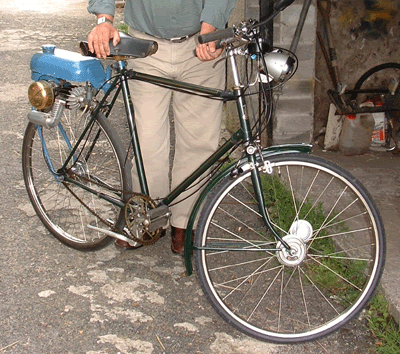JHC
Chief assistant to the assistant chief
Do you remember this little beauty, I had one when I was courting and money was very tight, from memory it did about 250 miles per gallon and saved energy and money, it made the hills so easy and could get up to about 30mph and no road tax. Just for the record that is not me in the picture

The Trojan Minimotor was designed in 1946 by Vincenti Piatti and by 1948 was being manufactured, under licence, by the Trojan company of Croydon (the same company which made the well known Trojan vans used by Brooke Bond).
It must be remembered that in the years immediately following the war, Europe was desperate for transport. Nevertheless, it must have been quite a feat to have sold over 100,000 units by 1951.
The beauty of the Minimotor lies in its simplicity. The small two-stroke cylinder is hung beneath the petrol tank with one end of the crankshaft driving the magneto and the other end having a drive roller to bear on the rear tyre. There is no clutch but instead a handlebar lever operating a cable mechanism to raise or lower the engine onto the tyre. A small carburettor regulates the petrol flow, by handlebar control. Apart from the lifting mechanism that's all there is to it.
With easy, open access to the engine this really was a motor which could be decarbonised during your lunch break.
This is one of the early Mk I models; it lacks a decompressor and the handlebar lever pulls the engine down onto the tyre. This makes control of my early model, interesting.......... One is used to a 'clutch' lever engaging the drive when released, but on this early unit it works the other way round, squeezing the control engages drive, releasing it frees the drive, and this takes a certain mental agility, at least on the maiden ride!
Any comments?? Have you memories to share??

The Trojan Minimotor was designed in 1946 by Vincenti Piatti and by 1948 was being manufactured, under licence, by the Trojan company of Croydon (the same company which made the well known Trojan vans used by Brooke Bond).
It must be remembered that in the years immediately following the war, Europe was desperate for transport. Nevertheless, it must have been quite a feat to have sold over 100,000 units by 1951.
The beauty of the Minimotor lies in its simplicity. The small two-stroke cylinder is hung beneath the petrol tank with one end of the crankshaft driving the magneto and the other end having a drive roller to bear on the rear tyre. There is no clutch but instead a handlebar lever operating a cable mechanism to raise or lower the engine onto the tyre. A small carburettor regulates the petrol flow, by handlebar control. Apart from the lifting mechanism that's all there is to it.
With easy, open access to the engine this really was a motor which could be decarbonised during your lunch break.
This is one of the early Mk I models; it lacks a decompressor and the handlebar lever pulls the engine down onto the tyre. This makes control of my early model, interesting.......... One is used to a 'clutch' lever engaging the drive when released, but on this early unit it works the other way round, squeezing the control engages drive, releasing it frees the drive, and this takes a certain mental agility, at least on the maiden ride!
Any comments?? Have you memories to share??


